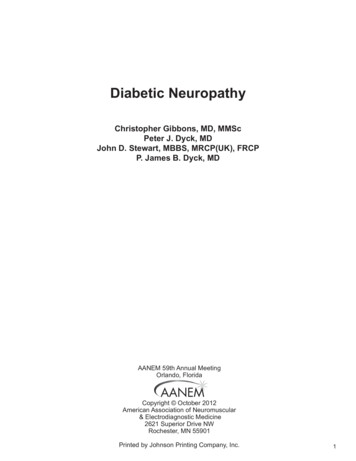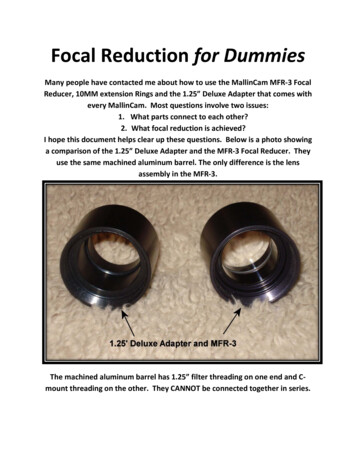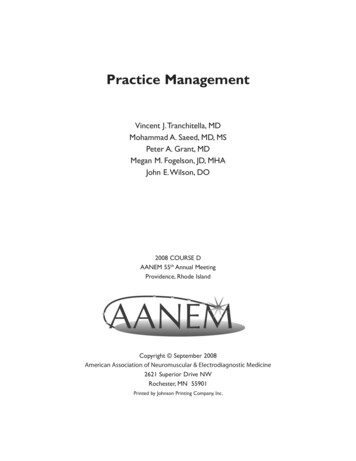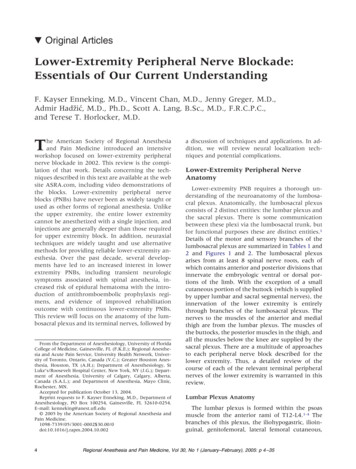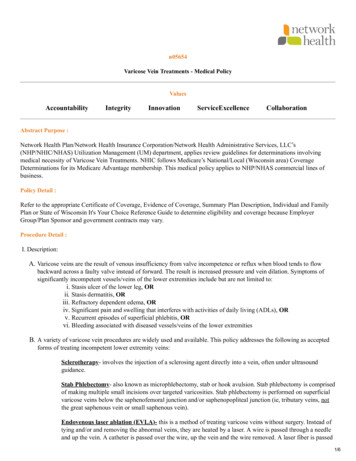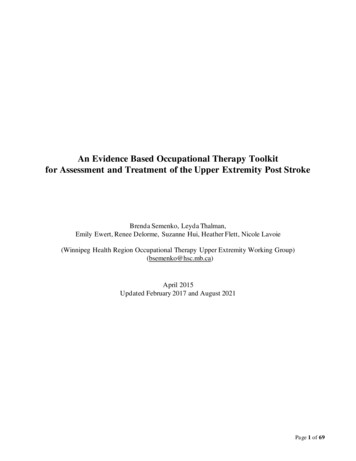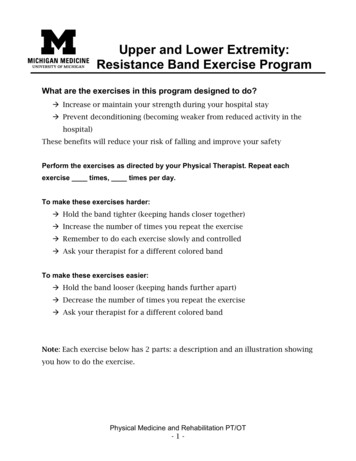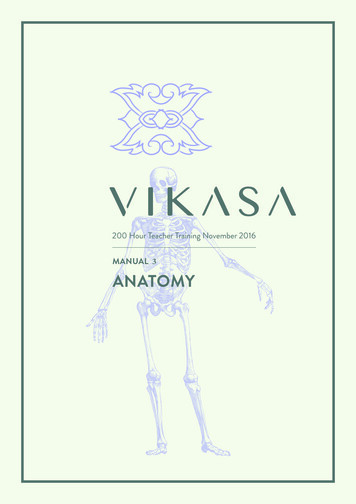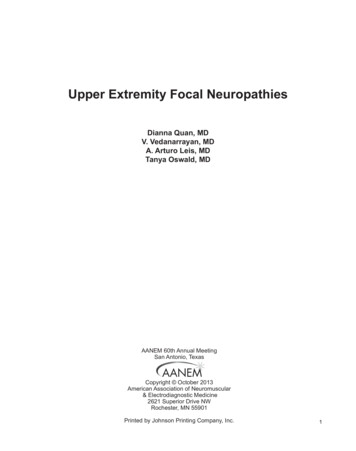
Transcription
Upper Extremity Focal NeuropathiesDianna Quan, MDV. Vedanarrayan, MDA. Arturo Leis, MDTanya Oswald, MDAANEM 60th Annual MeetingSan Antonio, TexasCopyright October 2013American Association of Neuromuscular& Electrodiagnostic Medicine2621 Superior Drive NWRochester, MN 55901Printed by Johnson Printing Company, Inc.1
Please be aware that some of the medical devices or pharmaceuticals discussed in this handout may not be cleared by the FDA or cleared by the FDA forthe specific use described by the authors and are “off-label” (i.e. use not described on the product’s label). “Off-label” devices or pharmaceuticals may beused if, in the judgment of the treating physician, such use is medically indicated to treat a patient’s condition. Information regarding the FDA clearancestatus of a particular device or pharmaceutical may be obtained by reading the product’s package labeling, by contacting a sales representative or legalcounsel of the manufacturer of the device or pharmaceutical, or by contacting the FDA at 1-800-638-2041.2
Upper Extremity Focal NeuropathiesTable of ContentsProgram Committee & Course Objectives4Faculty5Median Nerve Entrapment SyndromesDianna Quan, MD7Radial Nerve Focal NeuropathiesV. Vedanarayanan, MD11Ulnar Nerve Focal NeuropathiesA. Arturo Leis, MD15Surgical Treatment of Upper Limb NeuropathiesTanya Oswald, MD19CME Questions23No one involved in the planning of this CME activity had any relevant financial relationships to disclose.Authors/faculty have nothing to discloseChair: A. Arturo Leis, MDThe ideas and opinions expressed in this publication are solely those of the specific authorsand do not necessarily represent those of the AANEM.3
ObjectivesObjectives - Participants will acquire skills to (1) Explain the anatomy of the major nerves in the upper limb, (2) perform motor and sensory NCS inmedian, ulnar, and radial nerves, (3) discuss the common focal neuropathies and differential diagnoses affecting upper limb nerves, including CTS,ulnar neuropathy at the elbow, and Saturday night palsy, (4) understand the EDX strategy in focal neuropathies to arrive at a proper diagnosis, and (5)recognize the indications and types of surgery for focal neuropathies of the upper extremity.Target Audience: Neurologists, physical medicine and rehabilitation and other physicians interested in neuromuscular and electrodiagnostic medicine Health care professionals involved in the diagnosis and management of patients with neuromuscular diseases Researchers who are actively involved in the neuromuscular and/or electrodiagnostic researchAccreditation Statement - The AANEM is accredited by the Accreditation Council for Continuing Medical Education (ACCME) to provide continuingmedical education (CME) for physicians.CME Credit - The AANEM designates this live activity for a maximum of put in 3.25 AMA PRA Category 1 Credits . If purchased, the AANEMdesignates this enduring material for a maximum of 5.75 AMA PRA Category 1 Credits . This educational event is approved as an Accredited GroupLearning Activity under Section 1 of the Framework of Continuing Professional Development (CPD) options for the Maintenance of CertificationProgram of the Royal College of Physicians and Surgeons of Canada. Physicians should claim on the credit commensurate with the extent of theirparticipation in the activity. CME for this course is available 10/2013 – 10/2016.CEUs Credit - The AANEM has designated this live activity for a maximum of 3.25 AANEM CEU’s. If purchased, the AANEM designates thisenduring material for a maximum of 5.75 CEU’s.2012-2013 Program CommitteeVincent Tranchitella, MD, ChairYork, PARobert W. Irwin, MDMiami, FLDavid B. Shuster, MDDayton, OHThomas Bohr, MD, FRCPCLoma Linda, CAShawn Jorgensen, MDQueensbury, NYZachary Simmons, MDHershey, PAJasvinder P. Chawla, MBBS, MD, MBAAtlanta, GAA. Atruro Leis, MDJackson, MSJeffrey A. Strommen, MDRochester, MNMaxim Moradian, MDNew Orleans, LAT. Darrell Thomas, MDKnoxville, TN2012-2013 AANEM PresidentPeter A. Grant, MDMedford, OR4
Upper Extremity Focal NeuropathiesFacultyDianna Quan, MDA. Arturo Leis, MDDr. Quan received her undergraduate degree from the Universityof Chicago and her medical degree from Columbia UniversityCollege of Physicians and Surgeons. She completed her neurologyresidency and fellowship training in neuromuscular disorders andelectrodiagnosis at the Hospital of the University of Pennsylvania.She is currently professor of neurology at the University ofColorado Denver School of Medicine located in Aurora, where sheis program director of the neuromuscular medicine fellowship anddirector of the electromyography (EMG) laboratory. She has beenan active member of the American Academy of Neurology andthe American Association of Neuromuscular & ElectrodiagnosticMedicine, and serves as a medical editor for the online e-MedicineTextbook of Neurology and a frequent ad hoc reviewer for Muscle& Nerve, among other journals. Her interests include peripheralneuropathy, amyotrophic lateral sclerosis, and postherpeticneuralgia. Dr. Quan is an American Board of ElectrodiagnosticMedicine Diplomate.Dr. Leis received his medical degree from the University ofArizona, and completed his residency at the University ofTexas Health Science Center, and a fellowship at the Universityof Iowa Hospitals and Clinics. He is a clinical professor ofneurology at the University of Mississippi Medical Center andan electrodiagnostic consultant at the Methodist RehabilitationCenter. He has published more than 100 papers, letters, andchapters in peer-reviewed journals and is the author of Atlasof Electromyography, 2000, and Atlas of Nerve ConductionStudies and Electromyography, 2012 by Oxford UniversityPress. Dr. Leis’ major research focus is neuromuscular disorders,including West Nile virus infection and silent period studies.Professor of Neurology, Department of NeurologyProgram Director, Neuromuscular Medicine FellowshipDirector, Electromyography LaboratoryUniversity of Colorado Denver School of MedicineAurora, COVeda V. Vedanarayanan, MD, FRCPCProfessor of Neurology, Pediatrics and PathologyDirector, Division of Neuromuscular MedicineUniversity of Mississippi Medical CenterJackson, MSDr. Vedanarayanan received his medical degree from theUniversity of Madras, and completed residency training inneurology and child neurology from Duke University. He alsotrained in neuromuscular medicine at Johns Hopkins MedicalCenter. Dr. Vedanarayanan is a professor of neurology, pediatricsand pathology, and is the director of the Division of NeuromuscularMedicine at the University of Mississippi Medical Center. He isboard certified in neurology, electrodiagnostic medicine, clinicalneurophysiology, autonomic medicine and neuromuscularmedicine.Professor of Neurology, University of MississippiMedical CenterElectrodiagnostic Consultant, MethodistRehabilitation CenterJackson, MSTanya Oswald, MDPlastic and Hand Surgeon, Joseph M. Still Burn andReconstruction CenterCentral Mississippi Medical CenterJackson, MSDr. Oswald received her medical degree from the University ofMississippi Medical Center, where she completed her residencyin general surgery and residency in plastic and reconstructivesurgery. She also did fellowships in hand, peripheral nerve, andmicrosurgery medicine at Washington University in St. Louis. Dr.Oswald is currently a plastic and hand surgeon at the Joseph M.Still Burn and Reconstruction Center at the Central MississippiMedical Center in Jackson, MS. She also serves as an editorialboard member for Annals of Plastic Surgery. She is a member ofthe American College of Surgeons and the American Society forPlastic Surgeons, and has published 35 articles.5
6
Median Nerve Entrapment SyndromesDianna Quan, MDProfessor of Neurology, Department of NeurologyProgram Director, Neuromuscular Medicine FellowshipDirector, Electromyography LaboratoryUniversity of Colorado Denver School of MedicineAurora, COINTRODUCTIONMedian nerve entrapment is a common problem encountered inneuromuscular and electrodiagnostic (EDX) clinical practice.Most commonly, entrapment occurs at the wrist, resulting incarpal tunnel syndrome (CTS). Proximal injury is less commonbut well described and may occur as pronator syndrome (PS),anterior interosseous nerve syndrome (AINS), or supracondylarprocess syndrome due to injury at the ligament of Struthers (alsoknown as ligament of Struthers syndrome). This discussion willcover the anatomy of the median nerve, the clinical manifestationsof these four disorders, and the expected EDX findings.ANATOMYThe median nerve contains fibers originating from the C5 to T1nerve roots and all three trunks of the brachial plexus. Fibers fromthe medial and lateral cords join to form the median nerve, whichruns along the medial aspect of the arm, passing under the ligamentof Struthers (if present), under the lacertus fibrosis or bicipitalaponeurosis, between the two heads of the pronator teres muscle,and under the fibrous arch of the flexor digitorum superficialis(FDS) muscle, also known as the sublimis arch. Distal to this,the anterior interosseus nerve (AIN) arises from the radial aspectof the median nerve in most people and innervates the flexorpollicis longus (FPL), the flexor digitorum profundus (FDP) inthe radial aspect of the hand, and the pronator quadratus muscles.The median nerve proper continues into the distal forearm, givingoff the palmar cutaneous sensory branch to the base of the thenareminence before traversing an enclosed tunnel at the wrist formedby fibro-osseus elements and covered by the transverse carpalligament. The nerve is particularly susceptible to injury at severallocations along its course. From proximal to distal, these includethe ligament of Struthers, the proximal medial forearm around thepronator teres muscle, around the origin of the AIN, and in thewrist at the carpal tunnel.CARPAL TUNNEL SYNDROMECTS is the most common nerve entrapment encountered in clinicaland EDX practice. Because the tunnel is an enclosed space, anyprocess that reduces the volume of free space within may putpressure on the median nerve. Complaints typically involve acombination of pain, numbness, and paresthesias affecting thethumb, index finger, middle finger, and radial aspect of the fourthfinger. While strength in the ulnar aspect of the hand normally isunaffected, patients may complain nonspecifically of weaknessor clumsiness of the entire hand. Wrist flexion and extensionmay increase the pressure within the carpal tunnel causing morenoticeable symptoms during activities such as driving, holdingbooks or papers when reading, gripping and manipulatingsmall electronic devices, or other similar activities. Nocturnalawakening due to pain and paresthesias is common.Examination may reveal reduced sensation in the thumb, index,middle, and lateral aspect of the fourth fingers. Thumb oppositionand abduction may be weak, and, in more severe cases, thenaratrophy may be noted. Provocative maneuvers can be used toattempt to recreate symptoms in the office, though their sensitivityand specificity vary widely in the published literature.2 Phalen’ssign is present when complete palmar flexion of the wristproduces paresthesias and numbness. Tinel’s sign is present whenpercussion along the course of the nerve at the flexor retinaculumresults in median distribution paresthesias.7
MEDIAN NERVE ENTRAPMENT SYNDROMESEDX testing in milder cases may simply demonstrate slowingof sensory conduction velocity (CV) using a standard recordingtechnique between the proximal wrist and median-innervatedfingers. Milder cases may only demonstrate CV slowing onmeasurement across a short segment between the palm and wrist,thereby eliminating the contribution of more normal nerve in thedistal hand and fingers. With more severe involvement, largermotor fibers may also show focal slowing of CV across the wrist,visible as a prolonged distal motor latency of the compound motoraction potential. With even more severe pressure the medianinnervated hand muscles may have evidence of axonal damagewith acute or chronic denervation on needle electromyographic(EMG) examination.9ANTERIOR INTEROSSEUS NERVESYNDROMEIn the much less common AINS, the exact site of entrapment isprobably variable.5 The AIN separates from the median nerveabout 5-8 cm distal to the lateral epicondyle7 and may originatein association with arches formed by the FDS, deep head ofthe pronator teres, superficial head of the pronator teres, or acombination of fibrous arches from these muscles. Gantzer’smuscle, an accessory component of the FPL muscle may also play arole in AIN compression.3 Other possible sites of injury accordingto Spinner include the thrombotic ulnar collateral vessels, theaberrant radial artery, the tendinous origin of palmaris longus orflexor carpi radialis brevis, and an enlarged bicipital bursa.6 Insome cases, the problem is due not to structural impingement butrather spontaneous inflammation or ischemia.Symptoms and findings are predominantly motor. Patientscomplain of weakness of the thumb and index finger with difficultypinching items between these two fingers due to weakness of theFPL and radial portion of the FDP muscles. This can manifest asproblems using eating utensils, gripping a pen, or manipulatingsmall items with the thumb and index finger. Pain may be noted,but sensory loss should not be observed.The characteristic findings on clinical examination are relatedto dysfunction of these muscles. This is most obvious duringattempted pinching, which reveals an extended distal joint of theindex finger and thumb and exaggerated flexion of the proximalinterphalangeal joint of the index finger and metacarpophalangealjoint of the thumb. Pronator weakness is more subtle and must betested in elbow flexion to reduce the action of the pronator teresand highlight weakness of the pronator quadrates muscle. EDXtesting demonstrates denervation in the three muscles supplied bythe nerve.8PRONATOR SYNDROMEPronator syndrome may be a somewhat misleading name for thepain and median nerve distribution paresthesias experienced bypatients with entrapment in the proximal medial forearm, sincenot all cases involve the pronator teres muscle. As the mediannerve passes through the antecubital fossa, potential compressiveinjury may occur not only between the two heads of the pronatorteres, but also under the edge of the flexor digitorum sublimis arch,or occasionally under the lacertus fibrosis of the biceps tendon.8Pain may be exacerbated by simultaneous forearm pronationand extension of the elbow. The distribution of paresthesias andnumbness in the median distribution in the hand may suggestsymptoms of the more common CTS, but tenderness or a Tinel’ssign are expected at the region of the pronator teres rather thanat the wrist and decreased sensation may be identified along thethenar eminence, normally spared in CTS. Activation of the FDSof the middle finger against resistance may cause pain if the lesionis at the FDS arch.10 In the case of lacertus fibrosis compression,elbow flexion of the supinated forearm may reproduce orexacerbate symptoms.1,6Normal median CV at the wrist further distinguishes the problemfrom CTS. Focal slowing more proximally in the forearm maybe noted, though more detailed examination with inching studiesmay be needed to identify the specific area of slowing. If axonaldamage has occurred, needle EMG demonstrates denervationin median forearm and hand muscles but relative sparing of thepronator teres, depending on the exact site of compression.SUPRACONDYLAR PROCESS SYNDROMEEntrapment at the ligament of Struthers (a ligament whichconnects the medial epicondyle to an anomalous bony spurin the distal humerus) is rare among median nerve syndromes.This ligament is present in less than 3% of individuals1 and evenwhen present typically causes symptoms mainly in the setting ofsuperimposed trauma. Extension of the elbow, wrist, or fingersor forearm supination with the elbow extended may cause orexacerbate pain. Examination may demonstrate a palpable bonyanomaly and weakness in the median nerve distribution distal tothe entrapment, including the pronator teres. Slowing of medianCV across the site of entrapment may be observed with associateddenervation of distal median-innervated muscles in more severeor longstanding cases.SUMMARYMedian entrapment syndromes in the upper extremity arecommon, especially CTS, though more proximal injury is welldescribed particularly around the origin of the AIN, proximalmedial forearm around the pronator teres, and at the ligament ofStruthers. The clinical history provides important clues regardingthe lesion site, and physical examination findings includingprovocative maneuvers provide further localizing information.EDX testing is a key component of confirming the diagnosis andensuring appropriate treatment.
UPPER EXTREMITY FOCAL NEUROPATHIESREFERENCES1.2.3.4.5.6.7.8.9.10.Dang AC, Rodner CM. Unusual compression neuropathies of the forearm, part II:median nerve. J Hand Surg Am 2009;34:1915-1920.de Krom MC, Knipschild PG, Kester AD, Spaans F. Efficacy of provocative testsfor diagnosis of carpal tunnel syndrome. Lancet 1990;335:393-395.Dellon AL, Mackinnon SE. Musculoaponeurotic variations along the course ofthe median nerve in the proximal forearm. J Hand Surg 1987;12:359-363.Jacobson JA, Fessell DP, Lobo Lda G, Yang LJ. Entrapment neuropathies I: upperlimb (carpal tunnel excluded). Semin Musculoskelet Radiol 2010;14:473-486.Nagano A. Spontaneous anterior interosseous nerve palsy. J Bone Joint Surg (Br)2003;85:313-318.Spinner M. Injuries to the major branches of peripheral nerves of the forearm, 2nded. Philadelphia: WB Saunders; 1978. pp 162-192.Spinner M. The anterior interosseous nerve syndrome: with special attention to itsvariations. J Bone Joint Surg (Am) 1970;52-A:84-94.Tubbs RS, Marshall T, Loukas M, Shoja MM, Cohen-Gadol AA. The sublimebridge: anatomy and implications in median nerve entrapment. J Neurosurg2010;113:110-112.Werner RA, Andary M. Electrodiagnostic evaluation of carpal tunnel syndrome.Muscle Nerve 2011;44:597-607.Wertsch JJ, Melvin J. Median nerve anatomy and entrapment syndromes: areview. Arch Phys Med Rehabil 1982;63:623-627. Epub 1982/12/01.9
10
Radial Nerve Focal NeuropathiesVettaikorumakankav Vedanarayanan, MDProfessor of Neurology, Pediatrics and PathologyDirector, Division of Neuromuscular MedicineUniversity of Mississippi Medical CenterJackson, MSINTRODUCTIONRadial nerve entrapment syndromes are common, particularlyradial neuropathy at the arm (i.e., spiral groove), although radialmononeuropathies at other sites also occur. The etiology, generalcomments, clinical features, and electrodiagnostic (EDX) strategyfor these entrapment neuropathies will be reviewed.ANATOMYThe radial nerve is the largest branch of the brachial plexus,arising from the posterior cord and the fifth, sixth, seventh, andeighth cervical roots, with occasional contribution from the firstthoracic root. From its origin on the posterior axillary wall, itdescends behind the axillary artery to reach the angle betweenthe medial aspect of the arm and the posterior wall of the axilla(known as the brachio–axillary angle). Branches to the headsof the triceps and anconeus arise in the axilla and the brachio–axillary angle. The radial nerve inclines downward betweenthe long and medial heads of the triceps, after which it passesobliquely along the back of the humerus in the spiral groove(also known as the radial groove). Here it is in direct contactwith bone. The nerve then descends in the furrow between thebrachialis medially and brachioradialis laterally. The nerve givesoff branches to the brachialis (this muscle is supplied primarilyby the musculocutaneous nerve) and brachioradialis. The nerve isoverlapped, in turn, by the extensor carpi radialis (ECR) longusand ECR brevis. The radial nerve supplies both muscles, althoughthe ECR brevis may receive its nerve supply from the posteriorinterosseous nerve (PIN).5 Anterior to the lateral epicondyle, theradial nerve divides into its two terminal branches: the PIN andthe superficial radial nerve (SRN). The former is a pure muscularnerve that innervates the supinator before passing through thearcade formed by the superficial and deep heads of this muscle(i.e., arcade of Frohse). On the dorsum of the forearm, the PINdivides in a variable manner to innervate the extensor carpi ulnaris(ECU), extensor digitorum communis, extensor digiti minimi,abductor pollicis longus, extensor pollicis longus and brevis,and extensor indicis. The superficial radial branch is primarily asensory nerve. It provides cutaneous innervation to the dorsum ofthe hand lateral to the ring finger, the dorsum of the thumb, theradial aspect of the thenar eminence, and the dorsum of the index,middle, and radial half of the ring fingers as far distally as themiddle phalanx.Although the radial nerve, or its branches, may be involved inpenetrating injuries at any level, there are certain sites where thenerve is more prone to injury.5 In the brachio–axillary angle,compression may result from a misused crutch or from fracturesof the upper third of the humerus. In the region of the spiral grooveand lateral intermuscular septum, compression neuropathies ofthe radial nerve are common and widely recognized. The nerve ismost commonly damaged by fractures of the humerus or duringdeep intoxication with the arm draped over the edge of a bed,chair, or bench (known as “Saturday night palsy”). In its coursethrough the supinator (i.e., arcade of Frohse), the PIN is prone todamage from fractures of the upper third of the radius and lesscommonly from entrapment. Injury to the superficial radial branchmay result from tight handcuffs (known as handcuff neuropathy)or carelessly administered intravenous infusions.11
RADIAL NERVE FOCAL NEUROPATHIESRADIAL NERVE LESION IN THE ARMIn the region of the spiral groove, the nerve lies on bone andis commonly injured by a fracture of the humerus. It is alsocommonly injured by external pressure applied to the region ofthe spiral groove (e.g., Saturday night palsy).EtiologyCompression of the nerve in the spiral groove (i.e., radial groove)of the humerus can cause a radial nerve lesion in the arm. Asdescribed above, Saturday night palsy occurs when sedatives oralcohol produces deep sleep in someone and an arm is drapedover the edge of a bed, chair, or bench. “Honeymooner’s palsy”occurs when compression results from the weight of a partner’shead lying on the arm. A radial nerve lesion can occur secondaryto a fracture of the humerus, prolonged or excessive musclecontraction (e.g., experienced by masons, carpenters, or athletesin throwing sports), anatomical anomalies of the triceps, and deepintramuscular injections.General CommentsA radial nerve lesion in the arm is a common compressionneuropathy. Predisposing factors include diabetes, malnutrition,alcohol or sedative use, and hereditary susceptibility to pressurepalsies.1 The differential diagnosis includes lead poisoning,porphyria, diabetes, and periarteritis nodosa.Clinical FeaturesWrist drop occurs with a radial nerve lesion in the arm. Thereis normal function of the triceps (e.g., extension of forearm atelbow). There is weakness of the brachioradialis and all othermuscles supplied by the radial nerve beyond the spiral groove.Pain is not a typical feature, but it may be perceived in the area ofthe lateral epicondyle, radial styloid, or dorsum of hand. Numbnesscan occur in the distribution of the SRN and occasionally in theterritory of the posterior cutaneous nerve of the forearm. Mostcases of Saturday night palsy fully resolve in days to a few weeks,which is consistent with a demyelinating lesion. Delayed orincomplete recovery implies a greater degree of axonal loss.Electrodiagnostic StrategyNerve conduction studies (NCSs) are used to confirm a focallesion (i.e., conduction block, slowing of conduction velocity)at the spiral groove and to obtain information on the severityand prognosis. Cases characterized by conduction block resolvequickly; those with axonal loss and Wallerian degeneration showa reduction of motor or sensory amplitudes and resolve slowly orincompletely. In cases of axonal loss, needle electromyography(EMG) may show neurogenic changes (i.e., spontaneous activity,abnormal motor unit potentials, and abnormal recruitment) in thebrachioradialis and other muscles supplied by the radial nervedistal to the spiral groove. Needle EMG is normal in cases ofdemyelination and in the early stages of axonal loss in whichWallerian degeneration has not yet occurred. Needle EMG of thetriceps and anconeus is normal. The superficial radial sensoryresponse is reduced in amplitude or absent in cases of axonal12loss (normal in cases of demyelination and in the early stages ofaxonal loss). Needle EMG of non-radial–innervated C7 musclesmay be necessary to exclude C7 radiculopathy.RADIAL NERVE LESION IN THE AXILLAEtiologyCompression of the nerve in the axilla by high-riding crutches cancause the condition called “crutch palsy” or “crutch neuropathy.”Most cases of crutch neuropathy involve the posterior cord ofthe brachial plexus,4,5 although other cords and individual nervesmay also be affected. A radial nerve lesion can occur secondaryto shoulder trauma, humerus fractures, tumor, or anatomicalanomalies of the coracobrachialis or triceps.Clinical FeaturesWrist drop occurs with a radial nerve lesion in the axilla.Weakness occurs in all muscles supplied by the radial nerve,including the triceps. The triceps reflex is absent. Numbnessoccurs in the distribution of the SRN and occasionally in theterritories of the posterior cutaneous nerves of the forearm or armand inferior lateral cutaneous nerve of the arm. Most cases fullyresolve in days to a few weeks, which is consistent primarily witha demyelinating lesion. Delayed or incomplete recovery implies agreater degree of axonal loss.Electrodiagnostic StrategyAn EDX evaluation can obtain information on the severity andprognosis. Cases associated with axonal loss and Walleriandegeneration show a reduction of motor or sensory amplitudesand resolve slowly or incompletely. In cases of axonal loss, needleEMG may show neurogenic changes in the triceps and all othermuscles supplied by the radial nerve. Needle EMG is normal incases of demyelination and in the early stages of axonal loss inwhich Wallerian degeneration has not yet occurred. The superficialradial sensory response is reduced in amplitude or absent in casesof axonal loss (normal in cases of demyelination and in the earlystages of axonal loss). Needle EMG of non-radial–innervated C7muscles may be necessary to exclude C7 radiculopathy.POSTERIOR INTEROSSEOUS NERVESYNDROMEEtiologyCompression of the nerve as it passes between the two layers ofthe supinator muscle in the arcade of Frohse can cause posteriorinterosseous nerve syndrome (PINS). PINS can occur secondaryto radial subluxation, a fracture of the proximal radius, prolongedor repeated pronation–supination movements, tumors (lipoma),neuralgic amyotrophy, and compression by the ECR brevis.
UPPER EXTREMITY FOCAL NEUROPATHIESGeneral CommentsElectrodiagnostic StrategyPINS is also known as the “supinator syndrome.” Injury to thePIN usually is associated with trauma (e.g., fractures, gunshotwounds, lacerations) rather than with true entrapment.In a SRN lesion characterized by neurapraxia (i.e., demyelination)the superficial radial sensory response will be preserved. Thesepatients typically recover quickly. The superficial radial sensoryresponse will be reduced or absent in more severe cases associatedwith axonal loss (Wallerian degeneration). These cases recoverslowly or incompletely. Radial motor studies are normal. NeedleEMG is normal in all muscles supplied by PIN and the radialnerves.Clinical FeaturesThere is normal supination of the forearm and radial wrist extension(i.e., the supinator and ECR are normal). Weakness occurs in theECU; attempted wrist extension results in characteristic radialdeviation of the wrist. Weakness occurs during finger extensionand thumb extension. Thumb abduction may be normal becausethe abductor pollicis brevis (median nerve) is unaffected. Thereis pain in the lateral upper forearm (usually 5-8 cm distal to thelateral epicondyle). There is no sensory impairment because theSRN arises above the arcade of Frohse.Electrodiagnostic StrategyThe superficial radial sensory response is normal. Motor NCSsmay reveal a focal lesion (i.e., conduction block, slowing ofconduction velocity) across the entrapment.2 Cases characterizedby conduction block resolve quickly; those associated withWallerian degeneration show a reduction of motor amplitudeand resolve slowly or incompletely. Needle EMG may showneurogenic changes (i.e., spontaneous activity, abnormal motorunit potentials, and abnormal recruitment) in all muscles suppliedby the PIN below the supinator. Needle EMG of radial-innervatedmuscles (i.e., triceps, anconeus, brachioradialis, and ECR longus)is normal.REFERENCES1.2.3.4.5.Brown WF, Watson BV. AAEM Case Report #27: Acute retrohumeralradial neuropathies. Muscle Nerve 1993;16:706-711.Kimura J. Electrodiagnosis in diseases of nerve and muscle, 2nd ed.Philadelphia: FA Davis Co.; 1989. pp 499-500.Leis AA, Wells KJ. Radial nerve cutaneous innervation to the ulnardorsum of the hand. Clin Neurophysiol 2008;119:662-666.Raikin S, Froimson MI. Bilateral brachial plexus compressiveneuropathy (crutch palsy). J Orthop Trauma 1997;11:136-138.Sunderland S. Nerves and nerve injuries, 2nd ed. New York:Churchill Livingstone; 1978. pp 820-842.SUPERFICIAL RADIAL NERVE LESIONEtiologyCompression of the sensory branch of the radial nerve at the wristor distal forearm can cause a SRN lesion. The condition is called“cheiralgia paresthetica” when tight-fitting watches, bracelets,or bands compress the SRN. The conditi
in general surgery and residency in plastic and reconstructive surgery. She also did fellowships in hand, peripheral nerve, and microsurgery medicine at Washington University in St. Louis. Dr. Oswald is currently a plastic and hand surgeon at the Joseph M. Still Burn and Reconstruction Center at the Central Mississippi Medical Center in Jackson .
